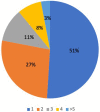Food protein-induced enterocolitis syndrome: Healthcare utilization and referral patterns among a pediatric cohort
- PMID: 36844887
- PMCID: PMC9956967
- DOI: 10.3389/falgy.2023.1102410
Food protein-induced enterocolitis syndrome: Healthcare utilization and referral patterns among a pediatric cohort
Abstract
Background: Food protein-induced enterocolitis syndrome (FPIES) is a non-IgE mediated food allergy characterized by delayed, repetitive vomiting. FPIES is improving in recognition; however, there remains a lag in diagnosis. This study aimed to further explore this lag, as well as referral patterns and healthcare utilization, to help determine areas for earlier recognition.
Methods: A retrospective chart review of pediatric FPIES patients at two hospital systems in New York was completed. Charts were reviewed for FPIES episodes and healthcare visits prior to diagnosis, and reason/source of referral to an allergist. A cohort of patients with IgE-mediated food allergy was reviewed for comparison of demographics and the time to the diagnosis.
Results: In total, 110 patients with FPIES were identified. The median time to diagnosis was 3 months, vs. 2 months in IgE-mediated food allergy (p < 0.05). Most referrals were from the pediatrician (68%) or gastroenterology (28%), none were from the ED. The most common reason for referral was concern of IgE-mediated allergy (51%), followed by FPIES (35%). There was a statistically significant difference in race/ethnicity between the FPIES cohort and IgE-mediated food allergy group (p < 0.0001), with a greater proportion of Caucasian patients in FPIES vs. IgE-mediated food allergy cohort.
Conclusion: This study demonstrates a lag in the diagnosis of FPIES and a lack of recognition outside of the allergy community, as only one-third of patients were considered to have FPIES prior to an allergy evaluation.
Keywords: FPIES; food allergy; healthcare utilization; non-IgE mediated food allergy; vomiting.
© 2023 Pier, Bingemann, Badwal, Rosloff, Pasha, Wang, Lomas and Järvinen.
Conflict of interest statement
The authors declare that the research was conducted in the absence of any commercial or financial relationships that could be construed as a potential conflict of interest.
Figures




References
-
- Nowak-Wegrzyn A, Chehade M, Groetch ME, Spergel JM, Wood RA, Allen K, et al. International consensus guidelines for the diagnosis and management of food protein-induced enterocolitis syndrome: executive summary—workgroup report of the adverse reactions to foods committee, American academy of allergy, asthma & immunology. J Allergy Clin Immunol. (2017) 139:1111–26. 10.1016/j.jaci.2016.12.966 - DOI - PubMed
Grants and funding
LinkOut - more resources
Full Text Sources

